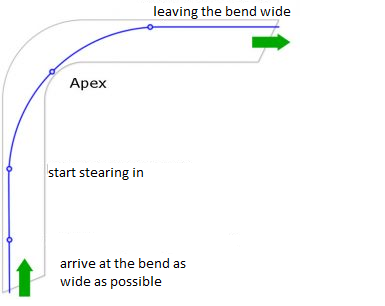Taking sharp turns
Cornering on the racing bike is harder than driving straight ahead. But there is much to gain, and as you get the hang of it, it’s also fun to do. But how do you ride a good curve, quickly and safely?
Down the drops
You can ride with hands on the hoods, but if you go fast and the curve is sharp, you have more control with your hands down the drops. (You need to exercise this regularly to be able to ride comfortable in this position.)
Keep your outside leg down and your inside leg up.
This is to ensure that you do not hit the ground, but above all to push the bike inward as the bicycle is pushed outward by centrifugal forces. Especially if it is (possibly) slippery, it is safer.

Look in the direction of where you want to go
Look forward in the direction where you want to go, not just right before you on the ground. By looking at where you want to go, you are riding a smoother line.
If your view of the road is obstructed by vegetation or rocks, you cannot fully see through a curve. You then look as far forward as possible to the outside of the road. That is the furthest away.

The good line in a curve is: outside-inside-outside
You go in the corner wide, move to the inside of the curve and exit wide again. In this way, the curve is less sharp and you can ride more easily and faster through it. If you’re riding on the (imaginary) center line of the road, the turn is less sharp. Do make sure there’s no traffic behind you. Or any oncoming traffic.
See also: Using the full width of the road http://www.smartercycling.cc/think-look-act-ahead/over-de-as-van-de-weg-rijden/
The descent by Roglic in the Tour de France, stage 17 is a example of more wringing than smooth decending.
Steering too much from the shoulders, body center of gravity (saddle) too far to the outside. Therefore he is wringing a bit and he is drifting out the curve. It seems that at the end of the curve, he has lost a lot of speed.
Also he takes the corner early, therefore he goes to the inside early, so the corner gets longer/rounder and therefore he comes out too wide.
This despite the fact that the descent of the Galibier is quite easy.
Remarkably, the commentators are talking about ‘fantasic descending skills’ and ‘an absolute terrific decent of the Galibier’. Perhaps it’s a matter of language, they speak more in superlatives. In any case, I do see his decend differently.
Interesting is an interview in which Roglic was asked whether his former career as a ski-jumper had offered him an advantage for descending. Yes, with regards to speed (up to 100 km per hour), but no further was his answer.
For ex-skiers, you often see that their cornering technique on the bicycle seems to benefit from their former carreer.
See also: http://www.smartercycling.cc/corners/aandachtspunten/
Steer with your weight more than with your steering wheel
By moving your weight to the inside of the turn you steer easier and safer than by turning the handle bars. To move your weight, press on the saddle with the inside of your thigh.

See also: the physics of taking turns
Keep your weight down
You may have a tendency to raise your torso in a curve. Practice to suppress this natural, but not very sensible, reflex.

Braking
Braking should be done before you enter a turn, and as late as possible. And hard enough so that you do not need to brake much in the turn itself. The front brake is the more efficient one.
In a turn, you can, if necessary, do some additional braking, but please only with the rear brake. If you lock your front wheel, you will almost certainly fall. Lock your rear wheel, chances are you immediately release the brake. In general, you’ll then have a lucky escape. And because the rear wheel slips slightly outwards, you’ve positioned yourself more favorably in the corner :). Mountain bikers and down hillers do consciously make use of this effect.

Slipping of the rear wheel as a result of the brakes locking the wheel, in general, gives fewer problems than when the rear wheel slipps out due to having the pressure on the inside pedal rather than on the outside pedal.
Taking turns in parts
In a part of a bend, the risk of slipping may be greater than in the rest of the bend. That may be due to sand, gravel, water, a white line you do not trust, a pot hole, or the like. Then, you are to partition that bend. In the good parts you take the turn sharp, and in the questionable parts less sharp. Especially with the skiing technique that will go easy. You push the bike more sharply (or less sharply) into the turn. This can also be achieved by moving your inside knee.
photo / video (to make yet)
See also: different turningtechniques
Starting to peddle again
On the exit, you can gently start pedaling, but remain in the saddle, so that the rear wheel does not break out. Only when you have straightened your bike, you can get out of the saddle.
photo / video (to make yet)
If you start to peddle too early in the turn, or get out of the saddle before you’ve straightened the bike, the pressure counteracting the centrifugal forces may be too small and your rear wheel may slip away.
After the bend
When exiting a turn, there is normally more distance between the riders. That’s a good time to check where everyone is. Or you want to play nice, for example, in a team time trial, let the others come back without much effort. If you want to put the hammer down, this is a moment to give some extra gas :).
See also: different turningtechniques
